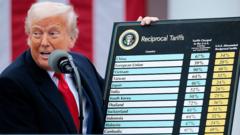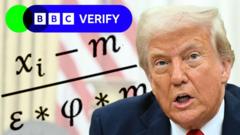In a significant policy shift, President Trump has introduced new tariffs that could reshape international trade dynamics and affect the U.S. economy.
Trump Unveils Sweeping Tariffs Impacting Global Trade

Trump Unveils Sweeping Tariffs Impacting Global Trade
Presidential announcement sets stage for a potential economic upheaval as global markets react negatively.
April 3, 2025, 4:42 p.m. ET - President Trump has unveiled an ambitious tariff initiative that promises to transform America's trade landscape. This bold policy, announced on Wednesday, represents a departure from long-standing import tax strategies, harkening back to the president's emphasis on bringing jobs back to the domestic economy.
Trump asserts that these tariffs are a necessary measure to recoup what he perceives as disadvantages imposed on American industries, claiming that the move will ignite a booming economic revival. “The markets are going to boom," he stated on Thursday, despite facing an immediate and drastic sell-off in global financial markets, marking one of the most significant downturns in years. The president accused other countries of decades of exploiting American trade policies.
In a marked contrast, economists are sounding alarms about the potential fallout. Many experts predict that the newly implemented tariffs, coupled with anticipated retaliatory measures from trading partners, may slow down economic growth, elevate consumer prices, and complicate operations for U.S. businesses reliant on international trade.
The president’s tariff strategy encompasses two main components. The first is a general tariff of 10 percent, which will apply broadly to nearly all imports, specifically exempting only goods from Canada and Mexico. The second component introduces a "reciprocal" tariff aimed at 57 nations that the administration identifies as maintaining higher tariffs or engaging in practices detrimental to U.S. exporters. This measure is framed as a way to ensure fairness in international trade relations, echoing the administration's longstanding narrative of combating unfair trade practices.
As reactions flow from both sides of the aisle and financial markets, the long-term impact of these sweeping tariffs remains uncertain, with many concerned about their implications for U.S. consumers and the global economy.
Trump asserts that these tariffs are a necessary measure to recoup what he perceives as disadvantages imposed on American industries, claiming that the move will ignite a booming economic revival. “The markets are going to boom," he stated on Thursday, despite facing an immediate and drastic sell-off in global financial markets, marking one of the most significant downturns in years. The president accused other countries of decades of exploiting American trade policies.
In a marked contrast, economists are sounding alarms about the potential fallout. Many experts predict that the newly implemented tariffs, coupled with anticipated retaliatory measures from trading partners, may slow down economic growth, elevate consumer prices, and complicate operations for U.S. businesses reliant on international trade.
The president’s tariff strategy encompasses two main components. The first is a general tariff of 10 percent, which will apply broadly to nearly all imports, specifically exempting only goods from Canada and Mexico. The second component introduces a "reciprocal" tariff aimed at 57 nations that the administration identifies as maintaining higher tariffs or engaging in practices detrimental to U.S. exporters. This measure is framed as a way to ensure fairness in international trade relations, echoing the administration's longstanding narrative of combating unfair trade practices.
As reactions flow from both sides of the aisle and financial markets, the long-term impact of these sweeping tariffs remains uncertain, with many concerned about their implications for U.S. consumers and the global economy.





















